Today, we are thrilled beyond measure to welcome Ashur, one of our wonderfully talented staff members, to the Free for All, to share with us the first in a series of posts devoted to all the wonder and joy to be discovered in the study of our spineless fellow creatures. We hope you enjoy, and can’t wait to learn more soon!
97% of all animal* species on Earth are invertebrates, meaning that they lack a spine. Despite these overwhelming numbers, when we think of animals, we typically think of vertebrates. Within this classification, we often think particularly those known as “charismatic megafauna” (which are overwhelmingly mammals): big cats, whales, bears, elephants; the poster children of popular endangered species conservation efforts that show up on postal stamps. Animals that you can expect to see at the zoo and that you go to the zoo specifically to see.
While the term “invertebrate” covers a huge number of species both extant and extinct (ammonites! The Burgess Shale!), today I want to give special attention to marine invertebrates. Don’t worry, the others will have their time in the sun sooner or later – consider this a series of posts.
I’ll start off by saying that I can’t do this vast family justice, here’s a broad and wholly incomplete list of some of the more well-represented marine invertebrates:

© David Moynahan
http://webhome.phy.duke.edu/~hsg/162/images/scallop-eye.html
-
- Bivalves: clams, scallops, oysters and others, many who are tragically delicious.
- Sea Snails (both with and without shells)
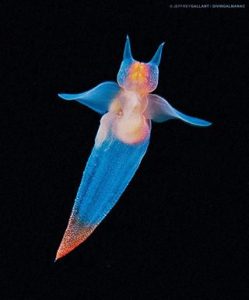
Photo © Jeffrey Gallant 2018; Aquatic Biodiversity Monitoring Network
- Sea Urchins: Sand dollars are a type of very flat sea urchin. If you meet a living sand dollar in the wild, please gently return it to the water.
- Sea Stars: Still known popularly as starfish, the term “sea star” is preferred because they’re not fish.
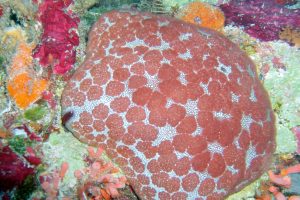
- Jellies
- Corals: Not a plant, but colonies of reef-building polyps
- Sea cucumbers: Are they as tasty as the vegetable cucumber? I personally don’t know, but the recipes are out there if you’re interested in trying it (or are already a devotee) but they swim better than the average cuke. Here’s one in action:
- Crustaceans: Crabs, shrimp, lobsters, crawfish, barnacles too! FUN FACT: His study of barnacles was instrumental Charles Darwin’s theory of speciation. So enamored was Darwin of the barnacle that he named one burrowing barnacle that he met Mr. Athrobalanus.
- Tube Worms
- Sea Spiders
The charismatic marine invertebrates are largely represented by the octopus, (though certain other cephalopods also attract public attention at times), which has enjoyed wide representation in recent and current non-fiction releases, as well as in the news.
- Within the last few weeks, a paper was published that posited that the octopus may have an extraterrestrial origin, thereby launching a thousand rebuttals in the popular press.
- The National Oceanic and Atmospheric Adaministration (NOAA)’s research vessel Okeanos Explorer (click here for live streaming!) made news in April when it captured captured images of what may be an unknown squid (?) in the Gulf of Mexico.
So what books do we have for the reader interested in invertebrates?
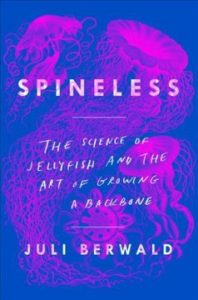 Spineless: The Science of Jellyfish and the Art of Growing a Backbone, by Juli Berwald: While cephalopods are the most popular marine invertebrates, jellies may be a close second for their grace, beauty, bioluminescence and untouchability. In popular-science-writing-meets- memoir text, Juli Berwald guides readers through the current science of jellyfish. Elegant in design, the contents are structured like a jelly’s life cycle.
Spineless: The Science of Jellyfish and the Art of Growing a Backbone, by Juli Berwald: While cephalopods are the most popular marine invertebrates, jellies may be a close second for their grace, beauty, bioluminescence and untouchability. In popular-science-writing-meets- memoir text, Juli Berwald guides readers through the current science of jellyfish. Elegant in design, the contents are structured like a jelly’s life cycle.
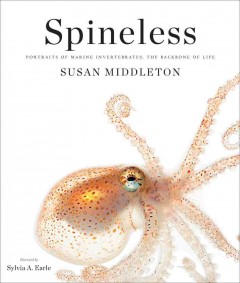 Spineless: Portraits of Marine Invertebrates, the Backbone of Life, by Susan Middleton : While Middleton’s book shares a title with Juli Berwald’s, they’re quite different; this Spineless is a striking gallery of 250+ underwater images (sprinkled with short essays and asides) taken of all manner of marine invertebrates. A good place to learn appreciation of the breadth of this group if you haven’t been appreciating them appropriately yet.
Spineless: Portraits of Marine Invertebrates, the Backbone of Life, by Susan Middleton : While Middleton’s book shares a title with Juli Berwald’s, they’re quite different; this Spineless is a striking gallery of 250+ underwater images (sprinkled with short essays and asides) taken of all manner of marine invertebrates. A good place to learn appreciation of the breadth of this group if you haven’t been appreciating them appropriately yet.
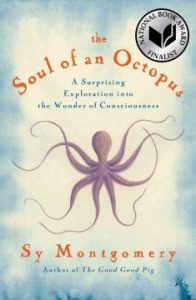 The Soul of an Octopus: A Surprising Exploration into the Wonder of Consciousness, by Sy Montgomery: In her widely-lauded book, popular naturalist Sy Montgomery has practiced true immersion journalism, the kind where you stick your hand in the water. From (our) New England aquarium tanks to the reefs of French Polynesia and the Gulf of Mexico, she has befriended octopuses with strikingly different personalities—gentle Athena, assertive Octavia, curious Kali, and joyful Karma. Each creature shows her cleverness in myriad ways: escaping enclosures like an orangutan; jetting water to bounce balls; and endlessly tricking companions with multiple “sleights of hand” to get food.
The Soul of an Octopus: A Surprising Exploration into the Wonder of Consciousness, by Sy Montgomery: In her widely-lauded book, popular naturalist Sy Montgomery has practiced true immersion journalism, the kind where you stick your hand in the water. From (our) New England aquarium tanks to the reefs of French Polynesia and the Gulf of Mexico, she has befriended octopuses with strikingly different personalities—gentle Athena, assertive Octavia, curious Kali, and joyful Karma. Each creature shows her cleverness in myriad ways: escaping enclosures like an orangutan; jetting water to bounce balls; and endlessly tricking companions with multiple “sleights of hand” to get food.
 Squid Empire: The Rise and Fall of the Cephalopods, by Danna Staaf: Remember what I said about cephalopods being marine invertebrate superstars? An epic half billion years of evolution brought one extraordinary group of animals from mud-grubbing snails to monstrous monarchs of the sea—and, eventually, to the calamari on your dinner plate. This book actually covers one of my favorite topics: extinct invertebrates! If this is your jam, run, don’t walk. If you’re interested in checking out this book, please speak to a staff member in reference.
Squid Empire: The Rise and Fall of the Cephalopods, by Danna Staaf: Remember what I said about cephalopods being marine invertebrate superstars? An epic half billion years of evolution brought one extraordinary group of animals from mud-grubbing snails to monstrous monarchs of the sea—and, eventually, to the calamari on your dinner plate. This book actually covers one of my favorite topics: extinct invertebrates! If this is your jam, run, don’t walk. If you’re interested in checking out this book, please speak to a staff member in reference.
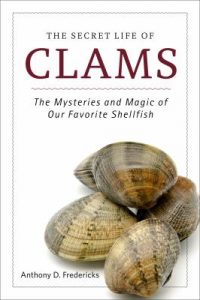 The Secret Life of Clams: The Mysteries and Magic of our Favorite Shellfish, by Anthony D. Fredericks How often do you think about the lives of clams, or other shellfish for that matter? Possibly often, depending on whether you have an invasive shellfish species affecting your local ecosystem. This book was designed to fill that knowledge gap and perhaps develop within you a greater appreciation of the clam. If you’re interested in checking out this book, please speak to a staff member in reference.
The Secret Life of Clams: The Mysteries and Magic of our Favorite Shellfish, by Anthony D. Fredericks How often do you think about the lives of clams, or other shellfish for that matter? Possibly often, depending on whether you have an invasive shellfish species affecting your local ecosystem. This book was designed to fill that knowledge gap and perhaps develop within you a greater appreciation of the clam. If you’re interested in checking out this book, please speak to a staff member in reference.
 The Secret Life of Lobsters: How Fishermen and Scientists are Unraveling the Mysteries of our Favorite Crustacean, by Trevor Corson: So many secret lives! If you like your invertebrates to have more than one foot, why not peer into the life of the lobster, crustacean symbol of coastal New England (sorry cod, you have a spine)?
The Secret Life of Lobsters: How Fishermen and Scientists are Unraveling the Mysteries of our Favorite Crustacean, by Trevor Corson: So many secret lives! If you like your invertebrates to have more than one foot, why not peer into the life of the lobster, crustacean symbol of coastal New England (sorry cod, you have a spine)?
If you’re interested in checking out this book, please speak to a staff member in reference.
 Rise, Ye Sea Slugs! a theme from In praise of old Haiku, with many more poems and fine elaboration, by Robin D. Gill: While this list is largely comprised of educational non-fiction, I would be remiss if I did not alert you to this splendid volume of over 900 translated haiku, all about sea cucumbers. I generally do most of my reading from books taken from the library; this is one I plan to own. If you’re interested in checking out this book, please speak to a staff member in reference.
Rise, Ye Sea Slugs! a theme from In praise of old Haiku, with many more poems and fine elaboration, by Robin D. Gill: While this list is largely comprised of educational non-fiction, I would be remiss if I did not alert you to this splendid volume of over 900 translated haiku, all about sea cucumbers. I generally do most of my reading from books taken from the library; this is one I plan to own. If you’re interested in checking out this book, please speak to a staff member in reference.
Hopefully you’ve enjoyed this brief foray into the exciting science and lives of marine invertebrates. More to come in the future!
*=the term “animal” includes insects
